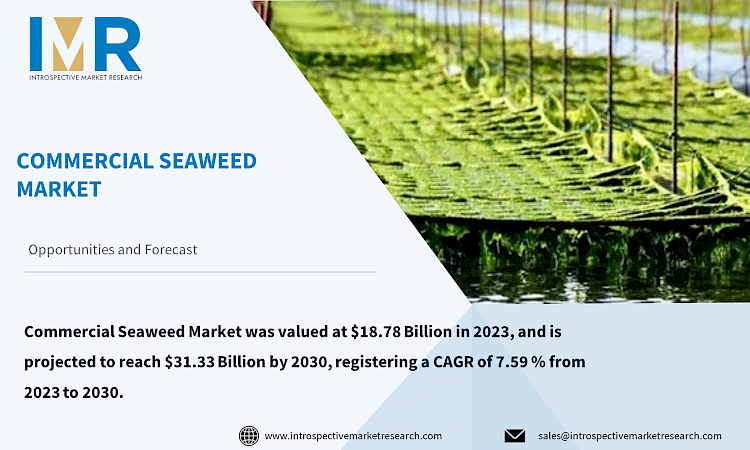
Commercial Seaweed Market was valued at $18.78 Billion in 2023, and is projected to reach $31.33 Billion by 2030, registering a CAGR of 7.59 % from 2023 to 2030.
Seaweed is a versatile commodity that is used for food and direct human consumption, as well as animal feed, cosmetics, agriculture, and other uses. Seaweed is a group of many kinds of sea algae. In essence, seaweed is harvested in the wild, but commercial seaweed farming has enhanced its availability. There are three types of seaweed: brown, red, and green. In addition, the market is expected to rise during the projected period as a result of the rapid expansion in seaweed cultivation due to a shortage of natural resources.
The market for commercial seaweed offers many advantages that highlight its increasing significance in a range of industries. First off, seaweed is a significant addition to diets all over the world due to its high nutritional content, which is comprised of vitamins, minerals, and antioxidants. Because of its sustainable cultivation, which uses fewer resources than traditional crops, it is a more environmentally responsible option for producing food and helps to sequester carbon, which slows down global warming. Seaweed's adaptability is further demonstrated by the variety of uses it has in agriculture, biofuel production, cosmetics, pharmaceuticals, and food and drink. Its popularity is increased by the fact that eating it has been connected to many health advantages, such as better immune system performance, weight control, and heart health.
Commercial seaweed is necessary to meet consumer diet demands and reduce the risk of certain diseases. Commercial seaweed helps the agriculture sector meet the growing need for hydrocolloids in the food and beverage industry, which drives market expansion throughout the projection period and provides acceptable yield quality and quantity. Growing consumer awareness of veganism and animal welfare, as well as rising demand for plant-based products, are major factors propelling the market's expansion. The belief that plant-based food is safer and healthier than animal-based products has led to a rise in the popularity of plant-based products in several industries, including the food and cosmetics sectors. The commercial seaweed market is expected to develop as a result of the increasing use of seaweed in the cosmetic and pharmaceutical industries.
The Asia Pacific region is where seaweed is primarily cultivated. Following its growth, this seaweed is dried and shipped to industrialized nations like North America and Europe where it is processed further and its extracts are extracted for use in end-user businesses. The Asia Pacific region's lack of technology contributes to higher worker engagement, which raises operating expenses. Therefore, the introduction of new technology, like automated harvesters and direct seeding technologies, can be implemented in many Asian countries to reduce labor participation. To enhance seaweed production and track seaweed biomass and habitat, the sector is also embracing new, trendy technologies like artificial intelligence, machine learning, and the Internet of Things. These developments are fueling the market's expansion.
Commercial Seaweed Market, Segmentation
The commercial seaweed market is segmented based on by type, form, application, and region.
Form:
Flakes is the market sector with the second-fastest rate of growth throughout the projected timeframe. Flakes are made from seaweeds such as wakame, dulse, kombu, kelp, and hijiki. Seaweed flakes are mostly utilized in food since they are a growing alternative to salt. Mostly, these are employed as seasonings. Seaweed flakes are consumed raw and utilized in culinary dishes in nations like China and Japan. The human body needs iron, magnesium, zinc, vitamin B12, and biotin from seaweeds. Additionally, they contain therapeutic qualities that help treat conditions like diabetes, obesity, prostate cancer, and lung cancer.
Application:
The dairy sub-segment of the food segment is anticipated to hold the greatest share of the seaweed farming market. Throughout the projected period, seaweeds used in dairy products under the food segment will dominate the application segment. The dairy industry uses a variety of seaweed extracts, including agar, carrageenan, and alginate. Dairy goods like cheese, creams, desserts, ice creams, dairy powder, and dairy drinks use these extracts as thickening and gelling agents. Alginates are also utilized as stabilizers to increase the viscosity of beverages made with milk, including milkshakes with chocolate.
Region:
North America, Europe, Asia Pacific, Latin America, the Middle East, and Africa make up the segments of the commercial seaweed market. North America holds the largest market share due to rising seaweed cultivation, rising end-user demand, and the expansion of plant-based goods. Asia-Pacific is the market leader for commercial seaweed due to some factors, including low labor costs, ample supply of seaweed raw materials, and the traditional adoption of commercial types of algae in China, Japan, and Vietnam. These factors have both driven market growth and secured the region's dominant market share.
Some of The Leading/Active Market Players Are-
- DowDuPont Inc. (US)
- Cargill Incorporated (US)
- CP Kelco US Inc. (US)
- J.M. Huber (US)
- Ocean Harvest Technology Ltd. (UK)
- Beijing Leili Agricultural Co. Ltd. (China)
- Seaweed Solutions AS (Norway)
- Nantong Xinlang Seaweeds and Foods Co. Ltd. (China)
- Groupe Roullier (France)
- Kerry Group Plc. (Ireland) and other major players.
Key Industry Developments
- In February 2022, Take Air, a biotechnology start-up based in Belgium that specializes in improving indoor air quality, announced the introduction of a novel technique called Biospheric Air Treatment that eliminates airborne viruses in buildings, including COVID-19. Take Air’s "Sea Aeration" method functions by adding a specially made bio-compound made of marine organisms and seaweed to a building's ventilation system. The bio-compound has been demonstrated in laboratory experiments to eradicate influenza viruses and other respiratory infections, including coronaviruses like COVID-19.
- In February 2022, KAUST, Saudi Arabia, is expanding the nation's seaweed and algae supply to bolster the Kingdom's fishing industry. Situated 100 kilometers north of Jeddah, the postgraduate research and teaching facility is engaged in projects aimed at supporting the Kingdom's Vision 2030 economic diversification plan, which includes bringing in over USD 4 billion in foreign and domestic investment into the fishing sector.
Key Findings of the Study
- North America grows due to plant-based demand; Asia-Pacific, led by China and Japan, dominates with ample seaweed and low labor costs.
- Seaweed's nutrients and adaptability fuel its use across agriculture, animal feed, food, cosmetics, and pharmaceuticals, spurring market growth and cooperation.




